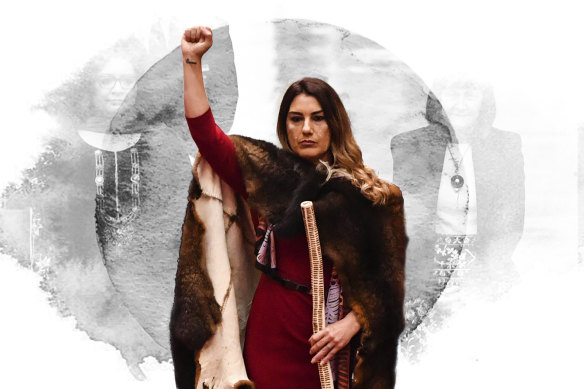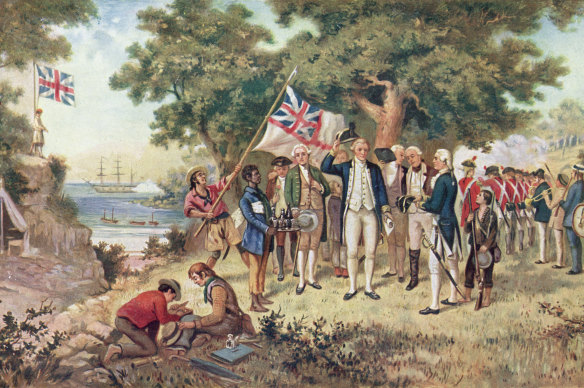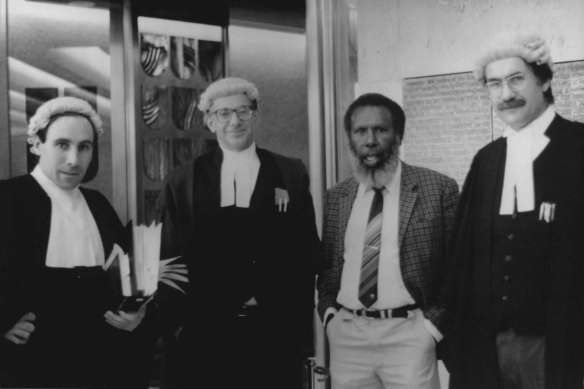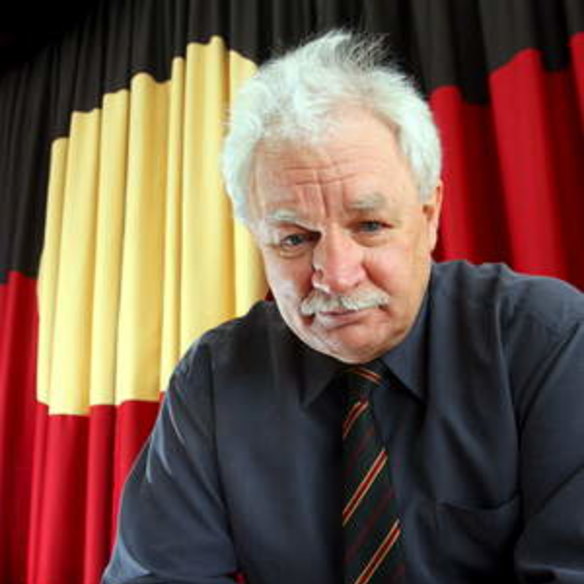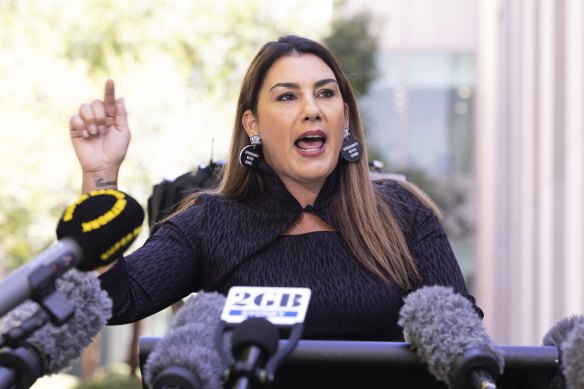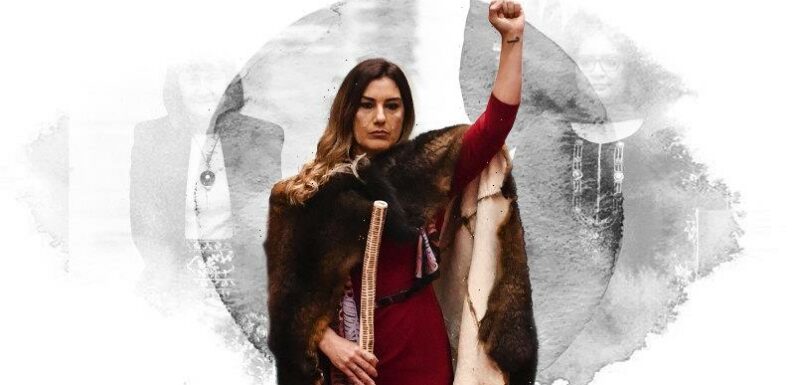
The concept of sovereignty goes back millennia – for many different cultures. What does it mean in Australia today?
A key concern for some Aboriginal and Torres Strait Islanders about the Voice to parliament is whether enshrining the body in the Australian Constitution – or recognising Indigenous peoples in any way in the nation’s founding document – extinguishes the sovereignty of First Nations people.
There’s a lot of confusion, misunderstanding and misconception around questions of sovereignty. It’s a complex and contested legal principle, and knowing what sovereignty is and how it interacts with First Nations sovereignty rights requires digesting a plethora of dense texts about the Constitution, including case law and government-commissioned reports. It’s not as simple as some activists would have you believe.
So what is sovereignty and how did the British settlers assume it over Australia? What is the First Nations sovereignty movement and what does it want? And how, if at all, will an Indigenous Voice, or a treaty, affect it?
Lidia Thorpe is sworn into the Senate in Canberra in 2020.Credit:Artwork: Monique Westermann, Getty Images
What did sovereignty look like in 1770?
When the British Crown’s imperial agents on HMB Endeavour first sighted New Holland on April 19, 1770, they recorded their observations. On board was a nine-man contingent of gentleman scientists led by the influential naturalist and botanist Joseph Banks. Banks and several others from the academy maintained journals, as did the commander of the voyage, Lieutenant James Cook and other seamen.
Over nine days, as the ship made its way north searching for anchorage to take on fresh water and provisions, they profiled the coast and shoreline, noting the conspicuous landmarks and recording the presence of the Aboriginal people of this so-called “unknown” land.
Cook had, months earlier, proclaimed British sovereignty over Aoteroa-New Zealand in the name of King George III. He was fulfilling secret instructions bestowed upon him by the Lords of the British Admiralty to “explore as great an Extent of the Coast” of New Holland as the expedition could, to map it, and to assess its resources. He was also to observe and document “the Genius, Temper, Disposition and Number of the Natives, if there be any and endeavour by all proper means to cultivate a Friendship and Alliance with them, making them presents of such Trifles as they may Value inviting them to Traffick, and Shewing them every kind of Civility and Regard.
“You are also with the Consent of the Natives to take Possession of Convenient Situations in the Country in the Name of the King of Great Britain: Or: if you find the Country uninhabited take Possession for his Majesty by setting up Proper Marks and Inscriptions, as first discoverers and possessors.”
As the ship progressed towards Kamay-Botany Bay, those writing journals recorded the use of fire by the Aboriginal inhabitants. By the fifth day, Banks noted the size of the fires had grown larger “than any we have seen before” and more numerous, from which he concluded that the land was “rather more populous” than first thought.
A painting of Captain Cook proclaiming British possession of the east coast of NSW in 1770.Credit:Getty Images
On April 25, botanical draughtsman Sydney Parkinson wrote of fires along the coast “lit up one after another, which might have been designed as signals to us”.
From the viewpoint of the Indigenous people on the beaches, headlands and in the hinterland of their ancestral Country, the fires were indeed signals: a chain of communication between neighbouring First Nations and a vigorous assertion of what we understand today as sovereignty.
Apart from Parkinson, the message was lost on the agents of the British Empire, as were the complexities of local customary laws, cultural protocols, governance systems, land cultivation and diverse economies. These were demonstrated by First Nations peoples in more than a dozen close interactions between the mariners and the natives before Cook proclaimed possession of “the whole Eastern Coast” in the name of King George III on August 22, 1770.
What does ‘Indigenous sovereignty’ mean?
Today, Indigenous sovereignty is understood to be inherent rights deriving from spiritual and historical connections to land. Distinguished Professor Aileen Moreton-Robinson – an academic and Goenpul woman from Minjerribah (Stradbroke Island), Quandamooka First Nation (Moreton Bay) – writes that “since spiritual belief is completely integrated into human daily activity, the powers that guide and direct the earth are believed to exist with all human life”. The first owners of the land were ancestral beings whose “creativity and incorporation into the land provides the basis for our sovereignty”.
The Uluru Statement from the Heart, from 2017, describes this form of “spiritual” sovereignty: “[T]he ancestral tie between the land, or ‘mother nature’, and the Aboriginal and Torres Strait Islander peoples who were born therefrom, remain attached thereto, and must one day return thither to be united with our ancestors … How could it be otherwise? That peoples possessed a land for sixty millennia and this sacred link disappears from world history in merely the last two hundred years?”
Familial and clan kinship systems with boundaries often defined by languages and customary agreements – which could be understood today as traditional treaties between different political entities and polities – were also integral components of First Nations sovereignties.
Moreton-Robinson says this concept of sovereignty was imperceptible to the likes of Cook and Banks. “Indigenous sovereignties challenge the philosophical premises of state sovereignty,” she says, because they don’t share the same ontology, or “ways of being”, as European perspectives of the concept.
Indigenous sovereignty has gained prominence internationally in recent decades, particularly in countries defined as “settler states” – modern nations whose territories were occupied by established indigenous populations before being colonised by imperial European powers. This revitalisation – or resurgence – of Indigenous sovereignty rights informs the 2007 United Nations Declaration on the Rights of Indigenous Peoples, a mechanism that, as Lenape scholar Joanne Barker puts it, identifies “a multiplicity of rights to political, economic and cultural self-determination”.
Australia, alongside Canada, New Zealand and the United States – all settler states with a common-law heritage and a diversity of First Nations sovereignties – initially voted against the UN General Assembly adopting the declaration, but later reversed their position.
The understanding of Indigenous sovereignty was not extinguished by conquest, discovery, domination, force or acquiescence and, as the High Court later found in the Mabo decision, the job was also not done by the 19th-century legal doctrine of terra nullius – or “nobody’s land” – which had been retrofitted to the Australian landscape.
Where did the Western version of sovereignty come from?
Academic historian Bain Attwood, at Monash University, points out that “sovereignty is not a word invented by Indigenous people”. The notion of state sovereignty is imperial, with Western legal roots, and allows absolute power and authority, usually through conquest of territory and the international law doctrine of “possessio” of property.
“The state of monarchy is the supremest thing upon the earth.”
The European concept is about 400 years old, though its roots can be traced back to the earliest customary law of the ancient Greeks, Romans, Egyptians and Israelites. State sovereignty stems from the writings of Jean Bodin, a 16th-century French philosopher and law theorist, who recognised kings and princes as instruments of God.
Later, the imperialist concept of sovereignty was developed by the English political philosopher Thomas Hobbes who posited that the absolute power of the sovereign was founded in the idea of a social compact composed of a polity’s subjects submitting, willingly and absolutely, to a person or agency in exchange for collective wellbeing and security. These notions informed peace treaties signed in 1648 in the Westphalian cities of Osnabrück and Münster (in modern-day Germany) to end the Thirty Years’ War in 1648. From those agreements, new regimes of power emerged.
The imperial notion of state sovereignty caught on across Western Europe, moving England’s King James I to tell parliament in 1710, “The state of monarchy is the supremest thing upon the earth.”
When most people refer to sovereignty or sovereign status, they’re deriving their understanding from the Westphalian concept. But as Moreton-Robinson notes, this imperial regime of sovereignty is uniformly white and male, and to conflate it with understandings of Indigenous sovereignties is to lead to confusion.
By the mid-1700s, jurists and political figures had developed principles that enabled sovereignty over land to be won not just by conquest or treaty, but through occupation. Attwood says the account of David Collins, the first legal officer of NSW, suggests the British government claimed sovereignty of the New South Wales territory based on the doctrines of discovery and possession of the land. Some have also argued that the British claimed sovereignty over Australia through the “Doctrine of Backward Peoples”, a tenet of 18th-century international law that entitled “more advanced peoples” to dispossess “uncivilised people”.
Terra nullius wasn’t widely applied in 1770 when Cook proclaimed possession, or even by February 7, 1788, when Governor Arthur Phillip proclaimed 3 million square kilometres of the colony of NSW in the name of King George III. Terra nullius, as a distinct doctrine, was invoked to justify British claims of territorial sovereignty in the 19th century.
Notions of state sovereignty have continued to change with technological innovations, global economies and trade, and other agreement-making in international law. Now, as Moreton-Robinson writes, sovereignty is no longer a cornerstone of modern politics.
The Mabo legal team; solicitor Greg McIntyre, barrister Ron Castan, Eddie Koiki Mabo and barrister Bryan Keon-Cohen at the High Court of Australia 1991.
How does the law view Indigenous sovereignty?
The High Court has addressed the question numerous times in the High Court, mainly in land rights cases. “In a traditional common-law legal sense, sovereignty has long been lost by Aboriginal and Torres Strait Islander peoples,” says constitutional expert Anne Twomey. “The High Court, the highest court in the Australian judicial system, for example, has recognised that Aboriginal people and Torres Strait Islanders are subject to Commonwealth, State and Territory laws, along with everyone else in Australia.”
The legal basis of sovereignty came into question in 1971, in the case of Milirrpum v Nabalco Pty Ltd in the Northern Territory Supreme Court, in which the Yolngu people of north-east Arnhem Land asserted native title rights, but that land rights case failed. In 1979, Wiradjuri man Paul Coe argued in the High Court that Aboriginal people were a sovereign nation, that Britain had wrongly asserted sovereignty over Australia, and that Australia was acquired by conquest, not settlement. The court held there was no Aboriginal nation exercising sovereignty in Australia. However, it did leave open the question of Aboriginal land rights.
Then, in the milestone Mabo decision in 1992, which wiped out the concept of terra nullius, the High Court held that First Nations people in Australia lived within applied systems of law before the arrival of Europeans. They therefore had a native title to the land.
In direct response to Mabo, the government of Paul Keating passed the Native Title Act, recognising some native title but not First Nations traditional customary laws. First Nations people can apply for native title rights over their own lands – within limits: they must demonstrate a continuous link to the land, and those whose claims succeed get limited rights – to hunt and hold ceremonies, for example, and to negotiate over any further “alienation” of their title from, say, an application to mine. It’s not ownership in the Western sense – they can’t sell the land or develop it. This is why Aboriginal rights activists maintain the provisions fall well short of the substantive land rights fought for since the early 1960s.
This did not see the end of the argument. In a 1993 High Court case, Isobel Coe argued the Wiradjuri nation had maintained some limited sovereignty, but the court held it did not exist in the form argued in the case, and that native title existed only “under the paramount sovereignty of the Crown”. Then in the 1996 Wik decision, the High Court ruled native title rights can coexist alongside the rights of a pastoral lease, but where there was a conflict in rights the native title was extinguished by the lease.
More recently, the High Court case of Love and Thoms v the Commonwealth in 2020 shows a shift in thinking about sovereignty. Among divided and contrasting opinions across seven judgments, Justice Gordon, in the majority, wrote: “European settlement did not abolish traditional laws and customs which establish and regulate the connection between Indigenous peoples and land and waters.”
Michael Mansell.Credit:
How have Indigenous sovereign activists viewed these questions?
Assertions of Aboriginal sovereignty raise questions for non-Indigenous Australians. Is the movement proposing one or more Indigenous governments? Does it mean First Nations people would pass their own laws, exercise their own customs, run their own community-controlled services? Will they try to collect taxes? Issue their own passports and postal stamps?
All of these things are already being done, and to varying degrees always have been done – for millennia – in First Nations communities around what sovereignty activists refer to as “so-called Australia”.
The Pakana lawyer and academic Michael Mansell, a Trawlwoolway-Pinterrairer descendent, has long argued for a new seventh state, comprised of a defined territory in Australia and made up of Aboriginal-owned or native title lands; as well as an elected assembly with powers of state governments and its own constitution. The Aboriginal Provisional Government group, formed in 1990 by Mansell and other Indigenous community leaders, was founded “on the principle that Aborigines are and always have been a sovereign people” and has for decades issued its own international passport – a document that has been officially stamped upon entry to several foreign nations and Indigenous territories abroad.
In the NT, community night patrols address over-policing and help cut crime while similar community-led organisations such as the Rumbalara Aboriginal Co-operative in Mooroopna, Victoria and many others around the country provide culturally informed health services to black and white community members. The Coalition of Peaks, the peak body for these community-controlled organisations, sits at the table of the National Cabinet.
Organisation such as Pay the Rent collect donations at most annual Invasion Day rallies on the east coast of Australia and send those funds towards resourcing First Nations-led social justice initiatives. In Victoria – a state that is progressing Voice, Treaty and Truth with its First Peoples – customary and cultural practices are recognised for Traditional Owners statewide (as opposed to in specific areas) when it comes to fishing and bag quotas, which exempt them from recreational fishing rules.
Elsewhere, Indigenous micronations such as the Murrawarri Republic have declared their independence from the Australian Commonwealth, drafting their own constitutions and, in the case of the Sovereign Yidinji Government, issuing its own currency and postal stamps.
Senator Lidia Thorpe delivers a statement to the media at Parliament House in Canberra in February.Credit:Alex Ellinghausen
How does Lidia Thorpe’s “sovereignty” fit?
The concept of Black sovereignty can be confusing. As distinguished professor Larissa Behrendt, a Eualeyai-Kamillaroi woman and University of Technology Sydney academic, has noted, it has come to mean different things to different Aboriginal and Torres Strait Islander communities. It is often used as a catchphrase for broad Indigenous rights – principally Aboriginal land rights, she says.
This diversity of understanding was acknowledged in a 2011 survey by the now decommissioned National Congress of Australia’s First Peoples, which found that some First Nations people’s understanding of sovereignty was informed by the Western notion of the concept.
“It’s not just a spiritual notion, it’s a position of power in this country that we’ve always had and that we will always have until we come to a peace agreement to be able to unite this country once and for all.”
It’s this notion that Senator Thorpe is referring to when she speaks of sovereignty. “The interpretation that the constitutional lawyers are bringing is the argument of the native title definition that our sovereignty is a spiritual notion,” Thorpe told NITV in February. “Well, I challenge that, it’s not just a spiritual notion, it’s a position of power in this country that we’ve always had and that we will always have until we come to a peace agreement to be able to unite this country once and for all.”
From this perspective comes Thorpe’s argument that we need a treaty before a Voice – giving First Nations people the standing of a state dealing with another state. On walking out of the National Convention at Uluru in 2017, she said: “We need to protect and preserve our sovereignty. We demand a sovereign treaty with an independent sovereign treaty commission, and appropriate funds allocated. We don’t need a referendum. We need a sovereign treaty.”
By contrast, Indigenous sovereignty scholars such as Taiaiake Alfred, a Mohawk man from the Wsanec Nation Territory on the Saanich peninsula in the modern nation-state of Canada, argues that Indigenous people need to “disconnect the notion of sovereignty from its Western legal roots and to transform it”. And Moreton-Robinson posits that her Goenpul sovereignty “differs from Western constructions of sovereignty, which is predicated on … the idea of a unified supreme authority, territorial integrity and individual rights”.
So, would the Voice (or recognition in the Constitution) extinguish Indigenous sovereignty?
Recent polling by Ipsos of around 300 First Nations people revealed that 10 per cent of respondents did not support the Albanese government’s proposed Indigenous Voice to parliament. Within this cohort lies the view that constitutional amendment recognising Aboriginal and Torres Strait Islander people would bring about a “cessation” of sovereign Indigenous rights.
The fear of recognition is rooted in a distrust of government. The expression “Sovereignty never ceded!” is embodied in the world’s longest-standing protest action, the Aboriginal Tent Embassy in Canberra, which was founded by members of the Aboriginal Black Panthers in 1972.
But constitutional law scholars, alongside international law experts and Voice advocates have labelled this suspicion “outlandish” and – at the request of Thorpe – have repeatedly declared that an enshrined Indigenous Voice cannot cede or extinguish Indigenous sovereignty. They point out that in international law, only an explicit, formal agreement such as a treaty mechanism between sovereign entities can lead to a cessation of sovereignty.
Uluru Dialogue co-chair Professor Megan Davis, a constitutional lawyer and Cobble Cobble woman from south-east Queensland, says Indigenous sovereignty co-exists with the Crown. “Since neither federation in 1901 nor the recognition of Aboriginal people as citizens in 1967 ceded Indigenous sovereignty, nor would a constitutionally enshrined Voice to Parliament … No one can cede sovereignty other than yourself or your people, your tribe, your nation.”
And lawyer Noel Pearson, a Guugu Yimithirr man, who is also a prominent Voice advocate, has long argued that local Indigenous sovereignty can exist within European concepts of sovereignty as long as self-determination rights such as those contained in the UN Declaration of the Rights of Indigenous Peoples are officially recognised and protected in common law.
In a 2012 report on Recognising Aboriginal and Torres Strait Islanders in the Constitution, the expert panel wrote: “It derives from the majority view of the High Court in Mabo v Queensland (No 2)52 that the basis of settlement of Australia is and always has been, ultimately, the exertion of force by and on behalf of the British arrivals.
“All members of the Expert Group agreed that the draft provision would not affect the sovereignty of any group or body.”
“Advice to the Panel is that recognition of Aboriginal and Torres Strait Islander peoples in the Constitution as equal citizens could not foreclose on the question of how Australia was settled. Nor should constitutional recognition in general have any detrimental effect, beyond what may already have been suffered, on future projects aimed at a greater place for customary law in the governance of Australia.”
A 2015 final report from a Joint Select Committee on Constitutional Recognition provided more detail: “The sovereignty of the Commonwealth of Australia … thus does not depend in any way on any act of original or confirmatory acquiescence by or on behalf of Australia’s indigenous peoples.”
The most recent legal advice from the constitutional law expert group advising the Prime Minister’s Referendum Working Group, issued on February 2, was the line: “All members of the Expert Group agreed that the draft provision would not affect the sovereignty of any group or body.”
So the Australian nation state, with its plurality of sovereignties – black and white – continues. Whether it can cope with a proposed Black Voice to Parliament enshrined in the very fabric of its Constitution is now the question.
Sign up for our Explainer newsletter – enlightening explanations for complex questions, delivered to your inbox every Sunday night.
If you'd like some expert background on an issue or a news event, drop us a line at [email protected] or [email protected]. Read more explainers here.
Most Viewed in National
Source: Read Full Article
